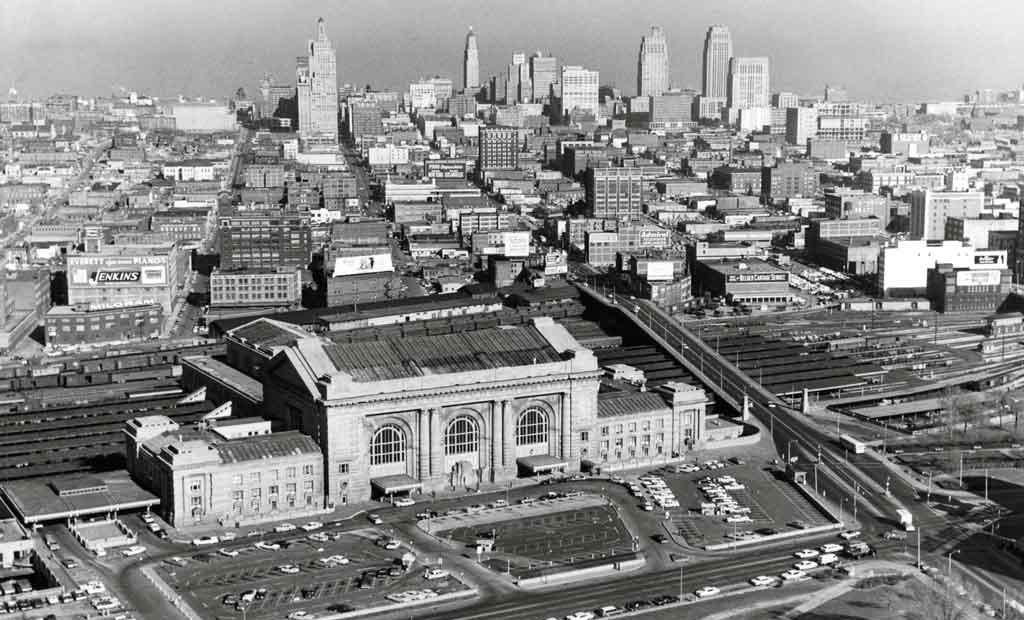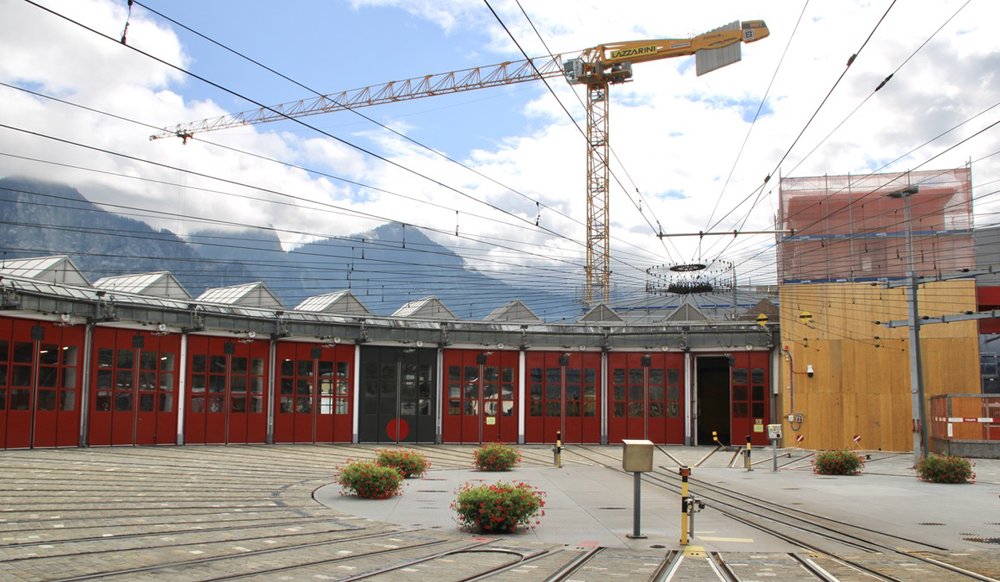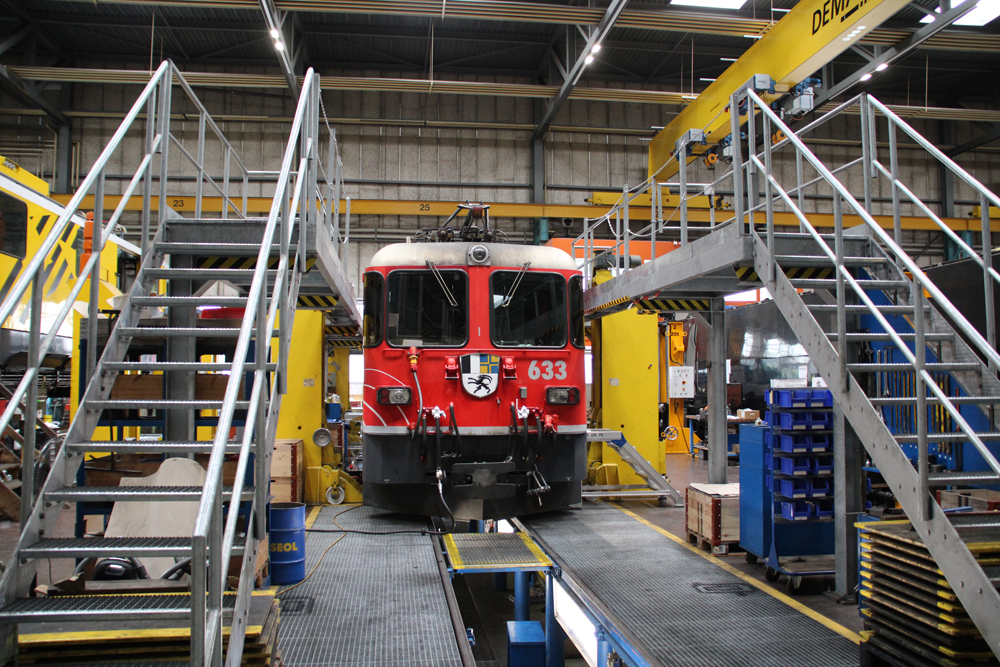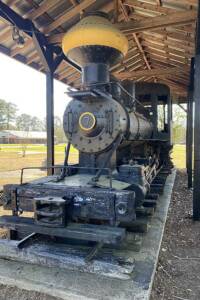
If you’re driving on Main Street through Hardeeville, S.C., it’s easy to miss the little steam locomotive tucked away in a small open shelter alongside the city’s library. As engines go, it doesn’t get much smaller than Argent Lumber Co. narrow-gauge 2-8-0 No. 7.
I found the engine, though, during a brief stop last week in Hardeeville. It took about five minutes to size up the 7, enough time for a quick photograph. The roof overhead offers a fair amount of protection — the rust is being held surprisingly in check — but the old 2-8-0 was down to the bare bones. No throttle, no headlight, no appliances, no builder’s plate (H.K. Porter, 1911), not even a barrier to keep kids out of the cab.
“Not much to see here,” I concluded.
But anything that lasts long enough deserves respect, so the saying goes, and that’s certainly true of the 7, not to mention the company that ran it. Argent was a small lumber company, already an anachronism when it began in 1916. It looked and behaved like a railroad from the 1870s, running a small fleet of engines that burned wood fuel, used link-and-pin couplers, and tip toed out into the cedar and pine swamps every day to feed the mill in town. It was 19th-century railroading deep into the 20th.
And that’s what made it briefly famous as photographers of the 1950s, desperately seeking steam, began rolling into town. Among them were Mallory Hope Ferrell, the dean of narrow-gauge authors. Ferrell’s “Argent: Last of the Swamp Rats,” published in 1994 by Pacific Fast Mail, was a model for how to do a book on something as downhome as Argent.
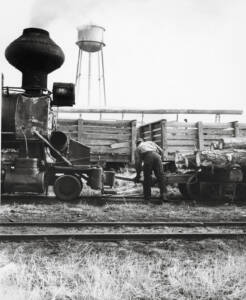
Then there was Jim Shaughnessy, that lion of railroad photography, who showed up with a friend in January 1956 to find Argent Lumber humming with activity, albeit on borrowed time. Jim’s photographs really capture the creaky charm of Argent. The images helped further the Argent legend when they first appeared in Trains magazine in a June 1956 article, and much later in a more lavish treatment in the Summer 2011 issue of Classic Trains, part of “The Shaughnessy Files” series that ran in the magazine. Argent developed an avid following, helped along no doubt by Jim’s perceptive pictures.
Argent was a classic lumber operation. Formed to take advantage of 8,000 acres of original-growth short-leaf pine along the southwest South Carolina border with Georgia, Argent’s railroad expanded over the decades to include an incursion into the Peach State via a 200-foot-long, second-hand highway swing bridge over the Savannah River. At its peak, the railroad consisted of 13 miles of “main line” from Hardeeville into Georgia, plus another 12 to 15 miles of spurs that spread through the forest like veins on a hand.
Argent’s tiny steamers rode across spongy ground atop 30- to 40-lb. rail on untreated ties. The track rested on a support system that involved driving wood piles into the soaked ground with a steam-powered pile driver. There were even stretches of dual-gauge track thanks to connections with Atlantic Coast Line and Southern.
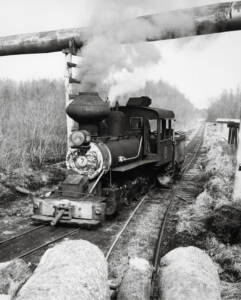
Out of the surrounding swamps came cypress, oak, gum, and juniper, or whatever pine was left, all delivered to a mill that could process 75,000 board-feet each day. According to Shaughnessy’s Trains story, the mill basically shut down after the federal government raised the minimum wage to $1 per hour in March 1956. The last steam operations apparently occurred in July 1958, when 2-6-0 No. 3 went back into the woods to pull remaining equipment back to Hardeeville. The dismantling continued into early 1959.
During his visit, Shaughnessy couldn’t help but marvel over Argent’s antediluvian technology. “A present-day OSHA or FRA inspector would suffer cardiac arrest with his first step onto the property,” he wrote. “A look into the locomotive cab revealed only the most basic controls, probably demanding a talent that might well evade a hogger who grew up on power that met more modern safety regulations.”
As if to underscore little Argent’s disproportionate legacy, all of its 1950s steam roster survives today. How many railroads can say that? In Iowa, the Midwest Central Railroad in Mount Pleasant keeps 2-6-0 No. 6 (Porter, 1914) in operation, along with inactive sister Mogul No. 2 (Baldwin, 1906). Up in Connecticut, 2-8-0 No. 4 (Porter, 1909) is in the collection of the Connecticut Antique Machinery Association. One engine — 2-6-2 No. 5 (Lima, 1910) — made it all the way to the Ardenwood Railroad in Fremont, Calif., where it remains in storage. Two others survive in the South, 2-6-0 No. 3 at the Southern Forest World Museum in Waycross, Ga. (Porter, 1905); and 2-6-0 No. 1 in private ownership in Warrior, Ala.
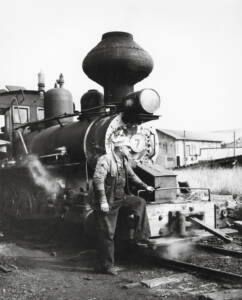
Then there’s No. 7, a bit bedraggled but safe under its shelter in Hardeeville. I checked in with Jennifer Combs, who runs the city’s parks and recreation department, and she hinted that better things might be in store for Argent’s 2-8-0.
“The city is in the planning process of a downtown municipal hub plan that will hopefully add some changes to the current park to make it a showcase park for visitors,” she told me. “I wish we had a caretaker (for the engine), but sadly we don’t. One of our long-range goals is to form a historical society and possibly have more citizen involvement on how these historical treasures are preserved.”
I hope that happens. The legacy of the Argent Lumber Co. railroad — a place Jim Shaughnessy described 67 years ago as “impossibly quaint” — deserves as much.






